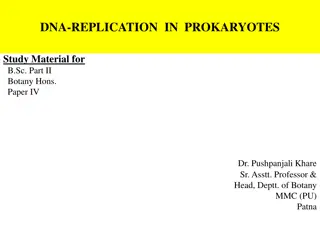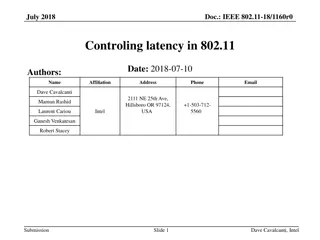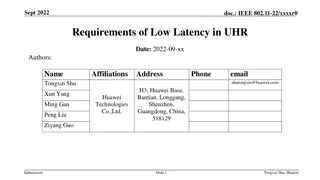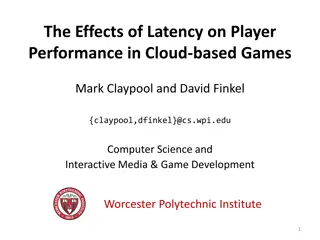Low-Latency Inter-Datacenter State Machine Replication Using Clock-RSM
Clock-RSM introduces a low-latency approach to inter-datacenter state machine replication by utilizing loosely synchronized physical clocks. This method ensures strong consistency, fault tolerance, and fast failover in a geo-replication environment. By overlapping ordering and replication using physical clocks, Clock-RSM achieves efficient command execution with reduced latency.
Download Presentation

Please find below an Image/Link to download the presentation.
The content on the website is provided AS IS for your information and personal use only. It may not be sold, licensed, or shared on other websites without obtaining consent from the author. Download presentation by click this link. If you encounter any issues during the download, it is possible that the publisher has removed the file from their server.
E N D
Presentation Transcript
Clock-RSM: Low-Latency Inter-Datacenter State Machine Replication Using Loosely Synchronized Physical Clocks Jiaqing Du, Daniele Sciascia, Sameh Elnikety Willy Zwaenepoel, Fernando Pedone EPFL, University of Lugano, Microsoft Research
Replicated State Machines (RSM) Strong consistency Execute same commands in same order Reach same state from same initial state Fault tolerance Store data at multiple replicas Failure masking / fast failover 2
Geo-Replication High latency among replicas Messaging dominates replication latency Data Center Data Center Data Center Data Center Data Center 3
Leader-Based Protocols Order commands by a leader replica Require extra ordering messages at follower client reply client request Follower Ordering Ordering Leader Replication High latency for geo replication 4
Clock-RSM Orders commands using physical clocks Overlaps ordering and replication client reply client request Ordering + Replication Low latency for geo replication 5
Outline Clock-RSM Comparison with Paxos Evaluation Conclusion 6
Outline Clock-RSM Comparison with Paxos Evaluation Conclusion 7
Property and Assumption Provides linearizability Tolerates failure of minority replicas Assumptions Asynchronous FIFO channels Non-Byzantine faults Loosely synchronized physical clocks 8
Protocol Overview client request client reply cmd2 cmd1 cmd1.ts = Clock() cmd2 PrepOK cmd1 cmd2 cmd1 Clock-RSM cmd2 cmd1 cmd2.ts = Clock() cmd2 cmd1 client request client reply 9
Major Message Steps Prep: Ask everyone to log a command PrepOK: Tell everyone after logging a command cmd1 committed? client request Prep R0 cmd1.ts = 24 PrepOK R1 PrepOK R2 PrepOK R3 cmd2.ts = 23 PrepOK R4 client request 10
Commit Conditions A command is committed if Replicated by a majority All commands ordered before are committed Wait until three conditions hold C1: Majority replication C2: Stable order C3: Prefix replication 11
C1: Majority Replication More than half replicas log cmd1 Replicated by R0, R1, R2 client request Prep R0 cmd1.ts = 24 PrepOK R1 PrepOK R2 R3 R4 1 RTT:between R0 and majority 12
C2: Stable Order Replica knows all commands ordered before cmd1 Receives a greater timestamp from every other replica client request cmd1 is stable at R0 cmd1.ts = 24 R0 R1 23 24 25 R2 25 Prep / PrepOK / ClockTime R3 25 R4 25 0.5 RTT: between R0 and farthest peer 13
C3: Prefix Replication All commands ordered before cmd1 are replicated by a majority client request cmd2 is replicated by R1, R2, R3 R0 cmd1.ts = 24 PrepOk R1 PrepOk PrepOk R2 Prep Prep R3 Prep R4 cmd2.ts = 23 client request 1 RTT: R4 to majority + majority to R0 14
Overlapping Steps client reply client request Prep cmd1.ts = 24 R0 PrepOK PrepOk Majority replication Log(cmd1) 24 25 Prep R1 23 PrepOK PrepOk R2 Stable order Log(cmd1) 25 Prep R3 Prefix replication 25 R4 25 Latency of cmd1 : about 1 RTT to majority 15
Commit Latency Step Latency Majority replication 1 RTT (majority1) Stable order 0.5 RTT (farthest) Prefix replication 1 RTT (majority2) Overall latency = MAX{ 1 RTT (majority1), 0.5 RTT (farthest), 1 RTT (majority2) } If 0.5 RTT (farthest) < 1 RTT (majority), then overall latency 1 RTT (majority). 16
Topology Examples Farthest R4 R3 Farthest R4 R1 R3 R2 R0 R1 Majority1 client request R2 R0 Majority1 client request 17
Outline Clock-RSM Comparison with Paxos Evaluation Conclusion 18
Paxos 1: Multi-Paxos Single leader orders commands Logical clock: 0, 1, 2, 3, ... client reply client request R0 Forward Commit R1 Leader R2 Prep PrepOK R3 R4 Latency at followers: 2 RTTs (leader & majority) 19
Paxos 2: Paxos-bcast Every replica broadcasts PrepOK Trades off message complexity for latency client reply client request R0 Forward R1 PrepOK Leader R2 Prep R3 R4 Latency at followers: 1.5 RTTs (leader & majority) 20
Clock-RSM vs. Paxos Protocol Latency Clock-RSM All replicas: 1 RTT (majority) if 0.5 RTT (farthest) < 1 RTT (majority) Paxos-bcast Leader: 1 RTT (majority) Follower: 1.5 RTTs (leader & majority) With realistic topologies, Clock-RSM has Lower latency at Paxos follower replicas Similar / slightly higher latency at Paxos leader 21
Outline Clock-RSM Comparison with Paxos Evaluation Conclusion 22
Experiment Setup Replicated key-value store Deployed on Amazon EC2 Ireland (IR) California (CA) Japan (JP) Virginia (VA) Singapore (SG) 23
Latency (1/2) All replicas serve client requests 24
Overlapping vs. Separate Steps IR VA CA JP SG Clock-RSM latency: max of three client request IR VA (L) CA JP SG Paxos-bcast latency: sum of three client request 25
Latency (2/2) Paxos leader is changed to CA 26
Throughput Five replicas on a local cluster Message batching is key 27
Also in the Paper A reconfiguration protocol Comparison with Mencius Latency analysis of protocols 28
Conclusion Clock-RSM: low latency geo-replication Uses loosely synchronized physical clocks Overlaps ordering and replication Leader-based protocols can incur high latency 29























